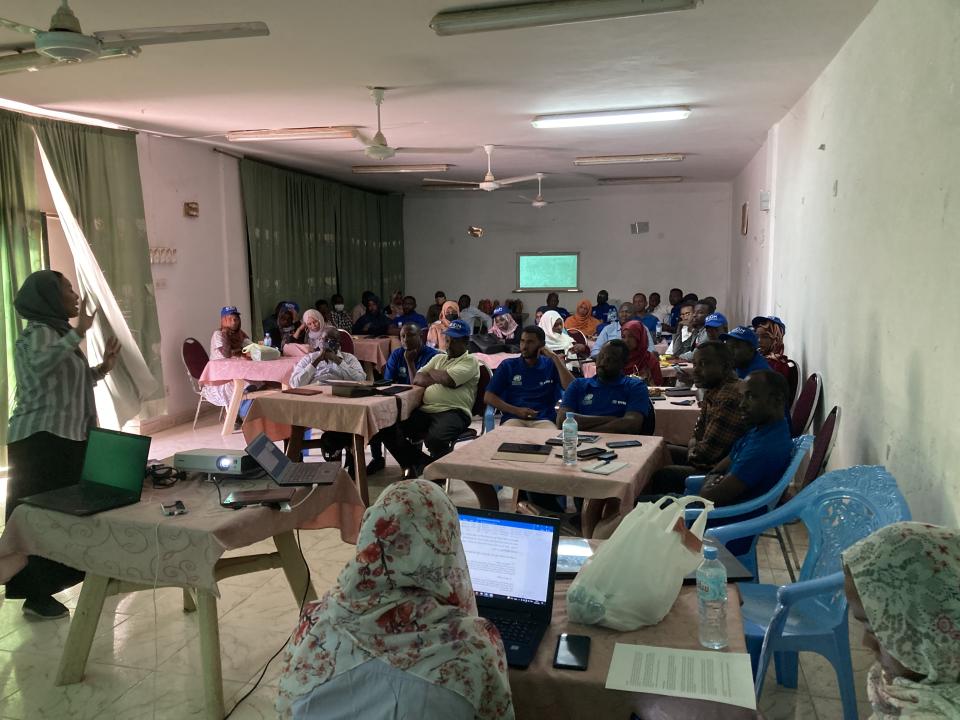Impact Evaluation Generates New Evidence about Peacebuilding in East Darfur

April 2024
Sudan’s Darfur region has witnessed high levels of violent conflict for over two decades, primarily driven by issues over land access between pastoralist and farmer tribes, as well as poor governance, access to basic services, and competition over resources. High levels of displacement have exacerbated these tensions: Before the escalation of violence in April 2023, Darfur hosted over 3 million internally displaced persons (IDPs).
In order to address these local conflict drivers the UN Secretary-General’s Peacebuilding Fund (PBF) invested over USD 20 million in projects aimed at addressing local conflict drivers in Darfur. The PBF investment, approved in 2020, comprised five different inter-agency and area-based projects implemented by FAO, IOM, UNDP, UN HABITAT, UNHCR, and UNICEF, the programme aimed to enhance good governance, provide durable solutions for displaced people, and build community resilience to resolve conflicts peacefully and avoid their escalation.
An impact evaluation conducted before the recent escalation of violence analyzed the effects of these projects. The Evaluation shows that the interventions supported by the PBF accomplished many objectives, notably reducing the number of local land conflicts, increasing rates of school enrollment and attendance, and improving perceptions of service provision in target communities. In targeted areas, about one household in 14 had one fewer land conflict – a substantial effect, given that a vast majority of households did not have a conflict to begin with. For members of a minority tribe, the results were much more dramatic, with a reduction of more than one conflict for every four households. Also, residents' perceptions of administrative and sanitation services improved, and a child in a PBF implementation village was 11 percent more likely to be enrolled in formal school.
As explained by a respondent in one village: “The (local peace) committee intervenes to resolve disputes. A network for the protection of women and children has also been formed to educate people about the seriousness of violence against women, rape, female genital mutilation and marriage ... There is a great change in the behavior of society compared to the past."
Despite the critical importance of peacebuilding programming and the increasing resources invested by donors of all stripes, rigorous quantitative impact evaluations of peacebuilding projects are rare, as shown in 3ie's peacebuilding evidence gap map.
The Peacebuilding Support Office is working to change that through the Peacebuilding Fund Impact Evaluation Learning and Dissemination (PeaceFIELD) initiative, which is generating new impact evaluations on essential but seldom evaluated types of peacebuilding programming. The Darfur evaluation is one of the initiative's initial case studies, which also include projects in Guatemala, on the Mali/Niger Border, on the Sierra Leone/Guinea border, and elsewhere in Sudan. These impact evaluations will contribute new insights about which types of interventions most effectively reduce the number of conflicts, improve social cohesion, and generate other key peacebuilding outcomes.
The initiative is implemented by the International Initiative for Impact Evaluation (3ie) and the International Security and Development Center (ISDC) with financial support from the German Federal Foreign Office and Global Affairs Canada. Launched in early 2021, the initiative is currently funded through 2024.
Impact evaluations differ from other types of evaluations in that they isolate the effects of a project and measure them quantitatively, including by comparing with places where no projects were implemented.
This East Darfur impact evaluation depended on the massive household survey collected by IOM at the start of the PBF project, funded through PBF projects across Darfur's five states. This survey collected rich social and economic data from 11,000 households, including information about land and land conflicts. Critically, the survey sampled widely around where the projects would be implemented – collecting responses from villages where PBF implementing agencies would be implementing activities as well as those where they would not.
The PeaceFIELD initiative collaborated with IOM again to collect endline data in East Darfur in March 2023, eight months after the project had ended, through a household survey of 3,512 individuals from 2,376 households. Along with the quantitative household survey, the IOM team collected rich qualitative data through interviews which helped explain how the improvements in services also contributed to peace.
Another respondent in a PBF implementation village said: “Projects such as education, water, health, and services provided in the area, such as issuing birth certificates, marriage certificates, and dispute settlement committees, are very important to the people of the region. In the event that they are not available, people wish to leave to other places to search for services and security.”
The Darfur Programme was selected as part of PeaceFIELD's initial scoping exercise to identify promising candidates for impact evaluations. The scoping effort prioritized projects which addressed certain key thematic learning priorities: issues related to land tenure; women's role in peacebuilding; security sector reform; and local justice mechanisms. After the thematic screening, the team checked to see which of those projects met the operational and logistical requirements for an impact evaluation. The project in East Darfur checked all the boxes. The final evaluation report was published on March 28 on 3ie's Development Evidence Portal.
In addition to yielding positive peacebuilding outcomes within local communities, the Darfur Programme also catalysed further peacebuilding support and funding in Sudan. UNICEF leveraged lessons learned from implementing the Darfur Programme to develop a programme implemented jointly with WFP on social cohesion and resilience in South, Central and North Darfur, which is funded by a EUR 100 million contribution from the KfW German Development Bank.

